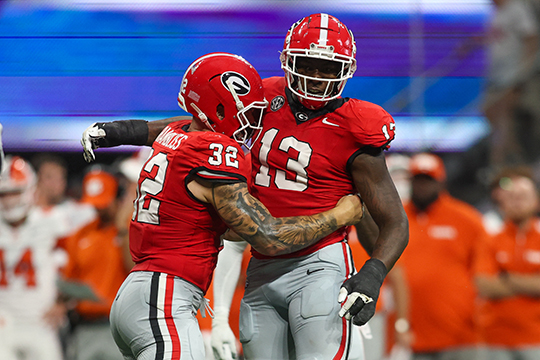Saints should avoid drafting raw edge rushers in first round

By Ross Jackson
Of all of the scenarios the New Orleans Saints could face in the 2025 NFL Draft, there is one they should absolutely avoid.
The team has been projected to do just about everything this offseason. Trade up, trade back, draft a quarterback, a running back, a tight end, and more. One scenario they should avoid at all costs: using a first-round pick on a developmental edge rusher with limited college production.
New Orleans has done this before, much to the chagrin of the fanbase. Former defensive end Marcus Davenport had all the traits to be great, but lacked impressive production while at the University of Texas San Antonio, with his top sack season coming his senior year with 8.5.
The Saints followed this up with the selection of now Dallas Cowboys edge defender Payton Turner, who had only 10 sacks in his four-year college career.
Being an edge defender is about much more than sacks, of course. But at the same time, teams pay for sacks when it comes to new contracts. So, they’ve got to mean something.
Turner and Davenport also dealt with injury issues heading into the league, another thing the team should look to avoid in a very important selection process.
This year’s raw, but very talented, pass rushers are Georgia defender Mykel Williams and Texas A&M pass rusher Shemar Stewart. To their credit, both play in the SEC, making their leap to the NFL a bit more predictable than the jumps from the FCS play that Davenport and Turner had to make.
Stewart finished his three-year collegiate resume with just 4.5 sacks, 1.5 in each year. Meanwhile, Williams capped off his trio of seasons with the Bulldogs securing 14 sacks, 4.5 the first two years and a small leap to five in 2024.
Stewart and Williams have the physical traits to take off at the next level. But the reason to avoid them isn’t necessarily about the player, but rather the team. The Saints will be installing a new defensive system with new defensive coordinator Brandon Staley. That might not be the ideal setting to take another early-round swing on a developmental edge rusher.
Additionally, Staley has been a defensive play caller for four years of his NFL coaching career. He called the 2020 Los Angeles Rams defense as the team’s defensive coordinator and then called the Los Angeles Chargers defense each of the next three years as head coach. His final season with the Chargers he called 14 of the team’s 17 games.
During those years, he’s had three edge rushers that secured more than 10 sacks in a single NFL season. Those players all checked specific boxes, in terms of their build, play style, and collegiate production.
- OLB Leonard Floyd: 6-foot-3, 240 lbs. with 17 collegiate sacks
- OLB Khalil Mack: 6-foot-3, 269 lbs. with 28.5 sacks
- DE Joey Bosa: 6-foot-5, 280 lbs. with 26 sacks
Compared to Stewart and Williams, the build is different. Smaller, athletic pass rushers have reigned supreme in Staley’s scheme. Even in cases where a prospect had a similar big-bodied athletic profile—like Bosa—he also brought proven college production to support his draft stock.
Steering clear of these project rushers isn’t about them not being promising prospects, they absolutely are. The decision should focus on the Saints’ system, which favors proven players over those built more on potential.
Players like Tennessee’s James Pearce Jr. and Marshall’s Mike Green may check enough boxes to be considered better gambles at No. 9 overall, instead. Meanwhile, more developmental edge rushers could be leaned on later in the draft. But with this year’s first round selection, it would make sense to avoid such a risk in favor of landing immediate production with more sure prospects, even those at a different position.










